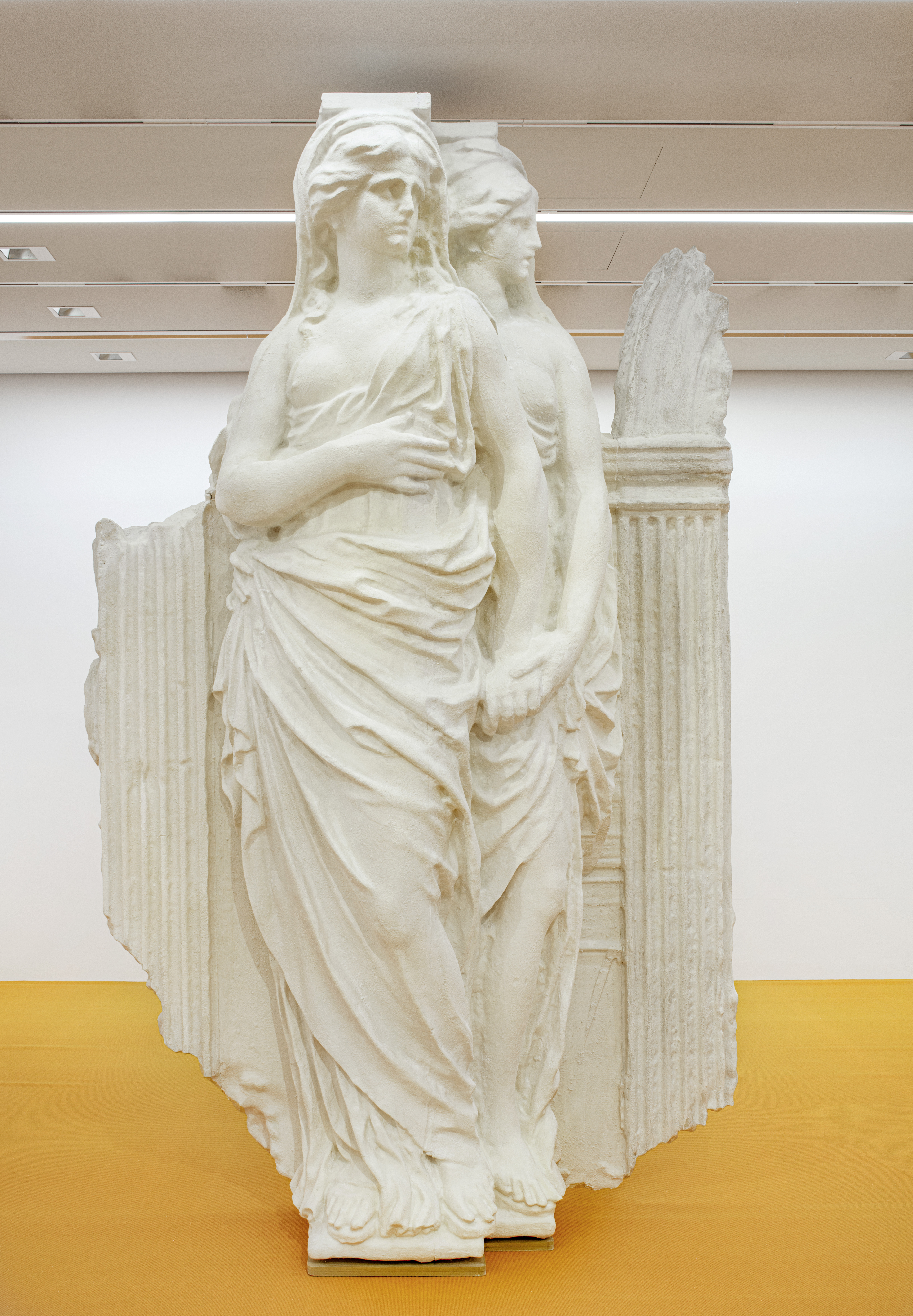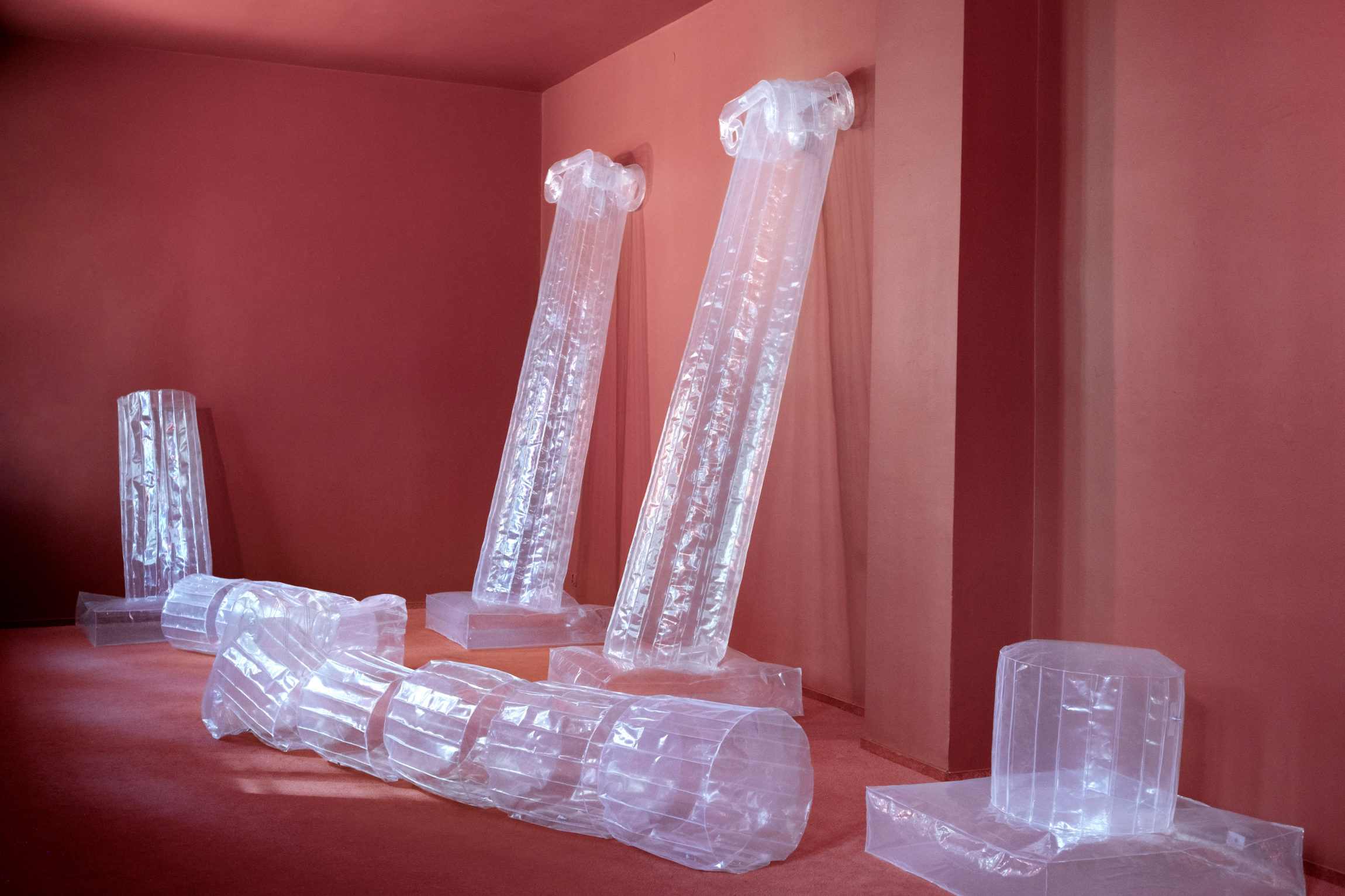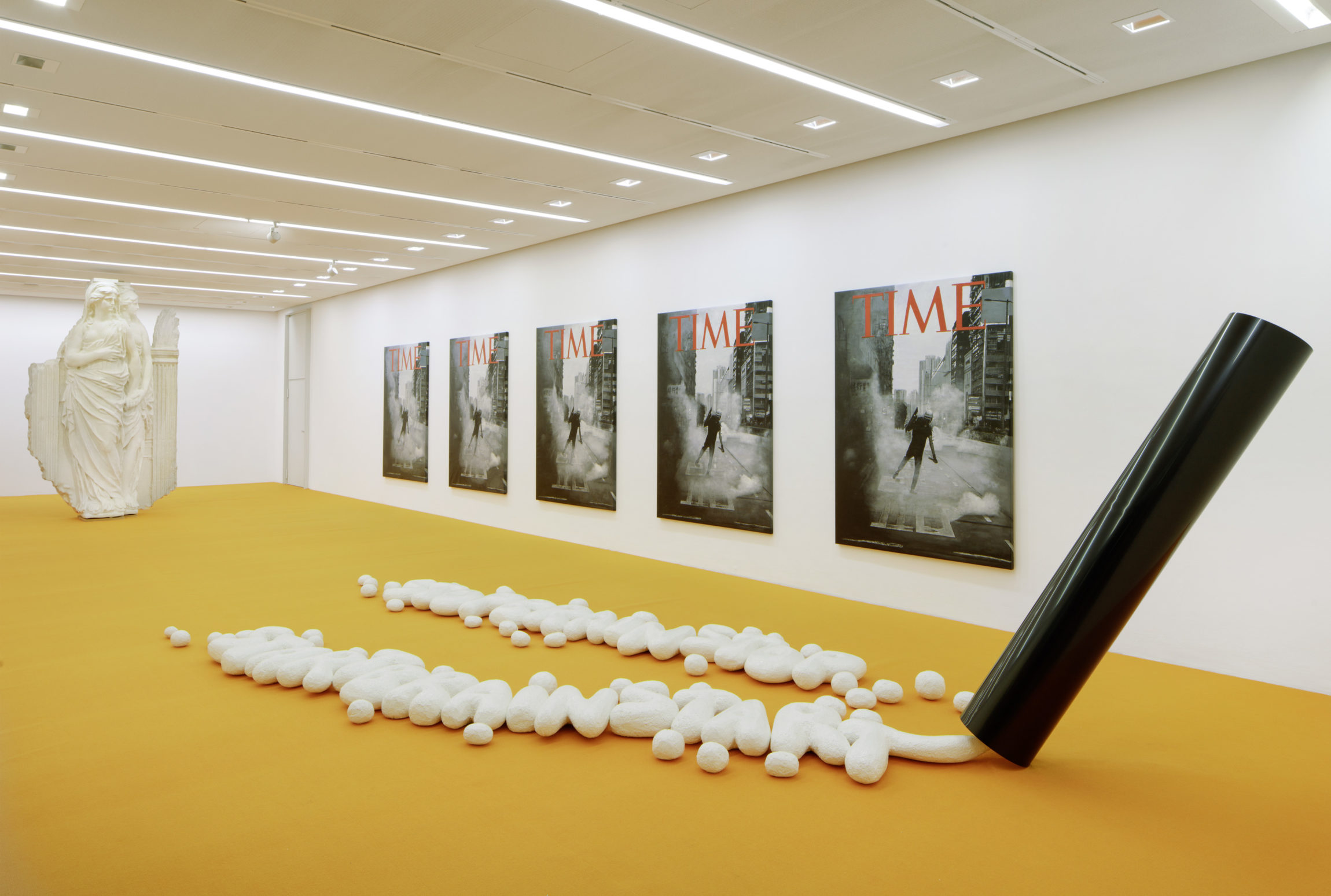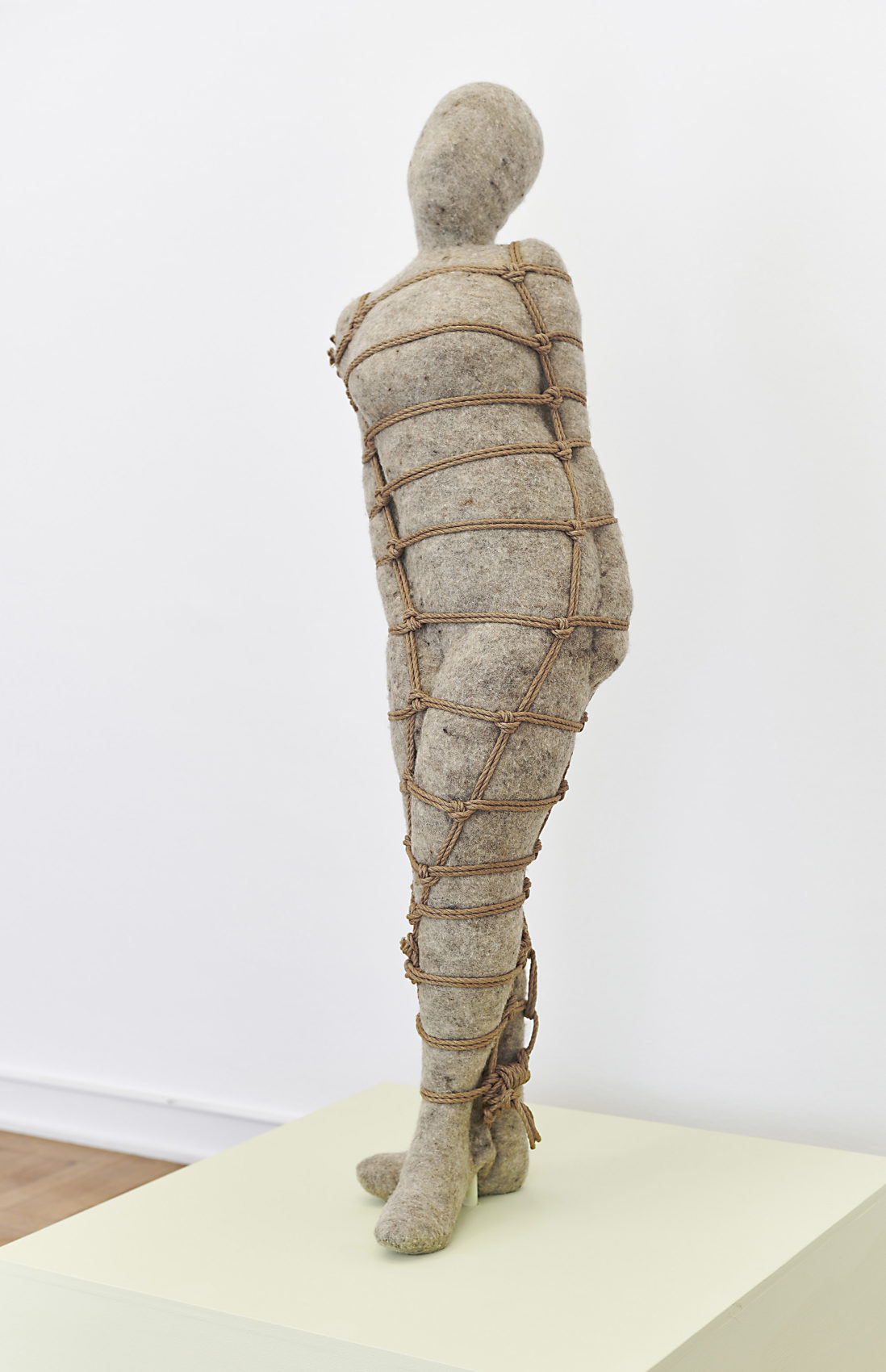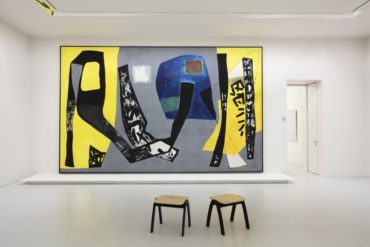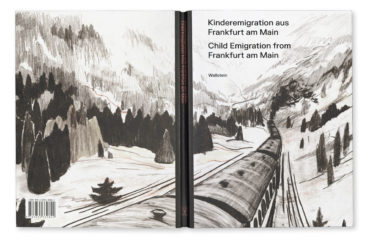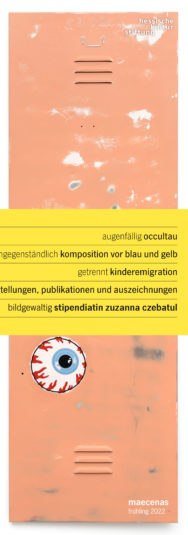scholarship-holder zuzanna czebatul
Zuzanna Czebatul (born 1986), who lives and works in Berlin, is a sculptor and interested in the idea of shattering all kinds of limitations. These may, for example, be traditional ways of seeing in art, the attributions of gender roles, or even seemingly unambiguous systems of rule. In 2013, she completed her studies in fine arts at the Städelschule in Frankfurt/Main and later attended the MFA program at Hunter College in New York on a Fulbright scholarship. She has had numerous international solo and group exhibitions, among them at Kunstpalais Erlangen and the Athens Biennale in 2021, Kunsthalle Bratislava (2019), and MINI/Goethe Institute Ludlow 38, New York (2015). In summer 2022, Czebatul will participate in the Geneva Biennale: Sculpture Garden.
Very recently, on the occasion of her first beautifully designed catalog being published, art magazine Monopol described the artist as “one of the most remarkable young sculptors”. With good reason, we feel!
Her highly evocative and not infrequently monumental sculptures are characterized by a heady material diversity, ranging from plush to PVC to concrete or steel. Czebatul does not consider any one material or subject to be more valuable than another, and she likens this to how she sees people and friendships: You like some because they’re quiet, others because they’re so lively. In her artistic practice, in which she likes to take up motifs that are ignored by society, she is never aiming to make an accusation, but rather seeks to visualize a problem.
In this interview, the artist talks to Dr. Sylvia Metz about the postponement of her travel scholarship, her first solo exhibition in Germany, her interest in architecture, and the necessity of advancing the socio-political debate both in and through art.
Sylvia Metz Zuzanna, for the year 2020 you were granted a travel scholarship from the Hessische Kulturstiftung and wanted to use it to travel to New York. But the trip has not come about so far because of the Covid-19 pandemic. What exactly did you want to do in New York?
Zuzanna Czebatul What I wanted – and still want to do – is to take a closer look at the history of New York’s stonemasons. The crafts and trade guilds that came about when the city was first established not only had an influence on the Reconstruction era from a technical and aesthetic perspective. The various trade associations, unions and representations also served to improve the status of craftsmen and their families and one result of this was they received a better education and were eligible for social security. It is really fascinating for me as a sculptor to examine these historical aspects and to explore why that cultural, economic and political foundation has become so porous today – perhaps as a reversal of social sculpture or its extension at an urban level.
Metz Will you now be able to carry on with your travel plans?
Czebatul Yes, the trip is to take place from April and I can hardly wait. The pandemic and I are working on it.
Metz One really can’t say that you have been idle in the meantime. You currently have a guest professorship at the Faculty of Visual Arts of Brno University of Technology and your works are showing at several international group exhibitions. Your first solo show in an art institution in Germany in Kunstpalais Erlangen has just come to a close. What was this exhibition about?
Czebatul My exhibition The Happy Deppy Ecstasy Institute asks questions about power, its symbolic embodiment and how the balance of power shapes our social reality. I not only produced new sculptures for Kunstpalais but also created an artistic spatial program that can be read as a parody of the time preceding the end of the world. On display were enormous gas pipelines, immense towers composed of body armor or the bootleg copy of a section from the Louvre’s facade – all the works reflect my fascination for geopolitical topics and monolithic forms.
Metz Metz A catalog was also published to accompany the exhibition. This book mirrors your already considerable international exhibition practice and your interest in political, cultural-historical and philosophical issues, not only through the selection of authors and their texts. Would you care to elaborate on the complexity of this monograph?
Czebatul The book truly is large and heavy, with a faux leather cover. The idea was for it to function as an object, with a feel that reflected my interest in both materiality and monumentality. Along with the invitation from the Kunstpalais came the wonderful offer to make an exhibition catalog. We invited authors and curators such as Kate Brown, Benoît Lamy de la Chapelle, Marie Madec and Tom Engels to engage with my work as I value their critical approach. Since I have always been slightly embarrassed about producing a real book for a single exhibition it seemed the right time to embark on a somewhat more detailed overview of my work. The Kunstpalais generously complied with my request, and I am very grateful for that. Consequently, the works listed in the monograph go back more than six years, and in between there are six extensive and wonderful text contributions as well as a gazette of sorts that features some of my political sources, inspirations, heroines and a bit of nonsense. The whole thing is put out by Distanz Publishing. I will plant at least one tree this spring!
Metz You broach two topics here that are important in understanding your work: Humor and your interest in societal processes. How do you unite them both in your works?
Czebatul George Bernard Shaw is purported to have said: “If you want to tell people the truth, you’d better make them laugh or they’ll kill you.” Even if I don’t know the truth, I try to tackle socio-political issues ambiguously so that there is room for interpretation. Sexy or joyful aesthetics are primarily fun and seductive, rather than acting as a deterrent to engagement. The two caryatids in my work Probably A Robbery (2021), ), a bootleg copy of a facade fragment from the Louvre, beguile through their grace and grandeur. I have looted these two women and then exhibited them entirely in the tradition of patriarchal imperialism. They can now be admired without shame while simultaneously pointing to the absurdity of their existence.
Another example is my 2019 exhibition T-Kollaps, in which I recreated a Greek temple as an inflatable ruin. The show took place at the GGM1 Municipal Gallery in Gdansk shortly after a fatal assassination attempt on the mayor of Gdansk who was a fierce critic of the right-wing Conservative government. Apart from the combination of colors the ruin, made of semi-transparent milky-white plastic and installed in the red exhibition space made no specific reference to the situation in Poland at the time and that is ongoing as it is not the only country where the pillars of democracy are being eroded or are even already in ruins.
Metz Metz The material you used in this exhibition was a cheap polyethylene. I understand your choice of material here (and in many of your other works) as criticism of society and simultaneously a political statement. Is that how you view it ourself?
Czebatul Yes, absolutely. Replacing marble with plastic speaks for itself. After all, the film is used as packaging material for consumer goods and lends something grotesque to the majesty of the original. At the same time, it is amazing that even as a cheap plastic imitation ancient architecture still radiates beauty due to its proportions and order. Once again, the iconography of occidental high culture is questioned and confirmed; this makes the fact that the West currently rests on the foundations of late Capitalism all the more worrying.
Metz Just where does your interest in architecture and monuments, mostly historical monumental ones, come from?
Czebatul When I think of sculpture my thoughts are not far removed from the house and we are the contents of the latter, after all. Objects like sculptures, memorials or monuments embody what we expect from houses, the only difference being that they also have to be functional. Which is why their dimensions are linked to and based on the human body. Power is always displayed in huge dimensions so as to let the inhabitants of a city know where they stand. The political aspect of artworks in public space is so exciting because the aim is to assign a place to all of us. It is, after all, the heterosexual white cis male body that has the most rights and freedoms, and accordingly is often presented honorably in clothing and on a horse, or at the very least on a pedestal. By contrast, the female body is typically naked and has neither any history nor personality, though it might perhaps express youthfulness. So, each epoch has its imperious forms of expression, sometimes they are very explicit, sometimes more abstract, but always they represent the current patterns of relations between those in rule and the ruled. The pieces erected in public space today are entirely in the service of a hyper capitalism that turns the balance of power back on us and makes us our own servants. The works of Jeff Koons, for example, testify to a shallow slickness that reflects commodity fetishism and the marketization of infantile freedom. Art in public space tends to consolidate domination and is rarely emancipating.
Metz Do you think that your art – and art in general – can expose these social entanglements and thus contribute to a change in these toxic patterns in relationships? While I’m asking you this, one thing I’m thinking about is your series Time Cloud (2021), with which you want to draw attention to the protests in Hong Kong in August 2019. Another thing that springs to mind is your Beuys work Kryptofaschistischer Verblendungszusammenhang (Crypto-Fas cist Concept of Total Delusion) that was presented 2021 in the exhibition Der Katalysator Joseph Beuys und Demokratie heute (The Catalyst Joseph Beuys and Democracy Today) in Museum Morsbroich…
Czebatul Well, I could now simply say “I really hope so” but that would be too simplistic. This question demands greater elaboration. For example, in China, there are entire villages where the division of labor and piecework are used to produce paintings for the European and American markets. Famous Western artists also have paintings made cheaply in China before having them sold at greatly inflated prices at international exhibitions. My Time Cloud series illustrates the complicated economic, cultural and political links between China and the West. When I first visited Hong Kong in August 2019, I bought the current issue of Time Magazine, , whose cover story was the pro-democracy movement. The cover featured a demonstrator surrounded by tear gas in a street with those high buildings so characteristic of the city. I had this image produced in quintuplicate by a Chinese manufacturer. By reproducing an image in China that is presumably subject to censorship, I address the conflicts arising from European history and the current economic relations associated with them.
In the installation Kryptofaschistischer Verblendungszusammenhang, a title as unwieldy as the legacy of Joseph Beuys’ I attempt to address the cultural-political and ideological constraints that artists can find themselves in after a certain stage of their career: For me, even after 100 years Joseph Beuys, who played a major role in shaping the cultural reconstruction of Germany which was still dominated by Nazi structures and individuals acts like a heat patch on the postwar cold and the faltering “de-Nazification” of Germany. His role in the Third Reich continues to be overshadowed by the 7,000 Oaks he planted, a feat considered to be pioneering against the backdrop of global warming, and I wish that he were studied more as a helper and accessory to a mammoth ideological undertaking rather than as an artist acting in his own right. He cannot be blamed for the form his work has taken, and it would be unfortunate not to examine his biography in terms of the function of culture.
Metz Are such investigations – and also the continuation of the socio-political discourse in and with art – a task for yourself and also for the upcoming generation of artists?
Czebatul Most definitely. I think it’s important to keep alive and pass on these debates including those surrounding the culture of remembrance. That’s exactly what I’m doing with my class in Brno: we’re looking at monuments, memorials and contemporary art in public spaces. The outcome of our semester will be on display at the Philara Collection in Duesseldorf at the end of February: The exhibition Adjustable Monuments, curated by Katharina Klang and Julika Bosch, explores new forms of memory culture. When I was invited to participate in this great project it seemed logical to include the next generation of cultural creators. Katharina and Julika accepted the invitation, and we are very happy to show eleven models of artworks in a comprehensive installation. The discourse must remain open and continue, there is still much to be done.
Metz That’s a very fitting closing remark. Thank you for this very interesting conversation.
Czebatul Thank you very much and I would like to recommend that you walk through your own city like a tourist because when I do I always notice expressions of historical or contemporary power relations I had previously overlooked. Even in Berlin, I am constantly discovering new things.
Translation by Dr. Jeremy Gaines
